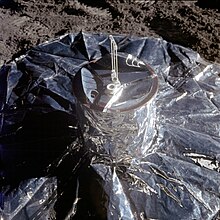
Apollo 12 was the sixth crewed flight in the United States Apollo program and the second to land on the Moon. It was launched on November 14, 1969, by NASA from the Kennedy Space Center, Florida. Commander Charles "Pete" Conrad and Lunar Module Pilot Alan L. Bean performed just over one day and seven hours of lunar surface activity while Command Module Pilot Richard F. Gordon remained in lunar orbit.

Apollo 14 was the eighth crewed mission in the United States Apollo program, the third to land on the Moon, and the first to land in the lunar highlands. It was the last of the "H missions", landings at specific sites of scientific interest on the Moon for two-day stays with two lunar extravehicular activities.

Apollo 16 was the tenth crewed mission in the United States Apollo space program, administered by NASA, and the fifth and penultimate to land on the Moon. It was the second of Apollo's "J missions", with an extended stay on the lunar surface, a focus on science, and the use of the Lunar Roving Vehicle (LRV). The landing and exploration were in the Descartes Highlands, a site chosen because some scientists expected it to be an area formed by volcanic action, though this proved not to be the case.

Apollo 17 was the eleventh and final mission of NASA's Apollo program, the sixth and most recent time humans have set foot on the Moon or traveled beyond low Earth orbit. Commander Gene Cernan and Lunar Module Pilot Harrison Schmitt walked on the Moon, while Command Module Pilot Ronald Evans orbited above. Schmitt was the only professional geologist to land on the Moon; he was selected in place of Joe Engle, as NASA had been under pressure to send a scientist to the Moon. The mission's heavy emphasis on science meant the inclusion of a number of new experiments, including a biological experiment containing five mice that was carried in the command module.
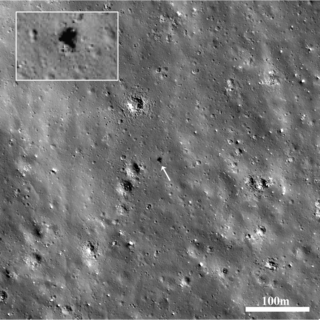
Surveyor 7 was the seventh and last lunar lander of the American uncrewed Surveyor program sent to explore the surface of the Moon. A total of 21,091 pictures were transmitted to Earth.

Surveyor 6 was the sixth lunar lander of the American uncrewed Surveyor program that reached the surface of the Moon. Surveyor 6 landed on the Sinus Medii. A total of 30,027 images were transmitted to Earth.

A seismometer is an instrument that responds to ground noises and shaking such as caused by quakes, volcanic eruptions, and explosions. They are usually combined with a timing device and a recording device to form a seismograph. The output of such a device—formerly recorded on paper or film, now recorded and processed digitally—is a seismogram. Such data is used to locate and characterize earthquakes, and to study the Earth's internal structure.
A geophone is a device that converts ground movement (velocity) into voltage, which may be recorded at a recording station. The deviation of this measured voltage from the base line is called the seismic response and is analyzed for structure of the earth.

The Pegasus Project was a NASA initiative to study the frequency of micrometeoroid impacts on spacecraft by means of a constellation of three satellites launched in 1965. All three Pegasus satellites were launched by Saturn I rockets, and remained connected with their upper stages.

The Fast Auroral SnapshoT Explorer was a NASA plasma physics satellite, and was the second spacecraft in the Small Explorer program (SMEX). It was launched on 21 August 1996, from Vandenberg Air Force Base aboard a Pegasus XL launch vehicle. The spacecraft was designed and built by NASA's Goddard Space Flight Center (GSFC). Flight operations were handled by GSFC for the first three years, and thereafter were transferred to the University of California, Berkeley's Space Sciences Laboratory.
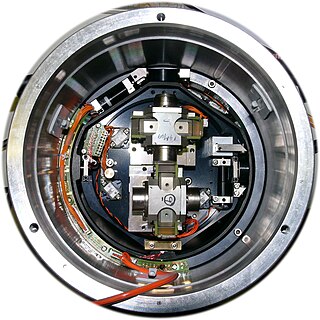
Passive seismic is the detection of natural low frequency earth movements, usually with the purpose of discerning geological structure and locate underground oil, gas, or other resources. Usually the data listening is done in multiple measurement points that are separated by several hundred meters, over periods of several hours to several days, using portable seismometers. The conclusions about the geological structure are based on the spectral analysis or on the mathematical reconstruction of the propagation and possible sources of the observed seismic waves. If the latter is planned, data are usually acquired in multiple points simultaneously, using so called synchronized lines. Reliability of the time reverse modelling can be further increased using results of reflection seismology about the distribution of the sound speed in the underground volume.
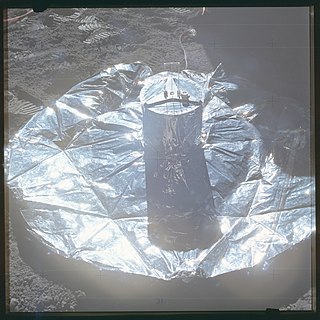
Lunar seismology is the study of ground motions of the Moon and the events, typically impacts or moonquakes, that excite them.
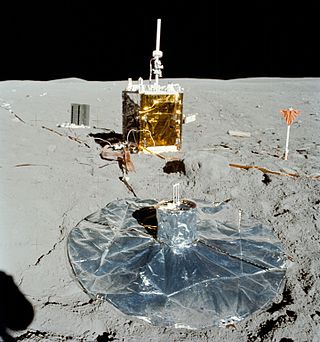
The Apollo Lunar Surface Experiments Package (ALSEP) comprised a set of scientific instruments placed by the astronauts at the landing site of each of the five Apollo missions to land on the Moon following Apollo 11. Apollo 11 left a smaller package called the Early Apollo Scientific Experiments Package, or EASEP.
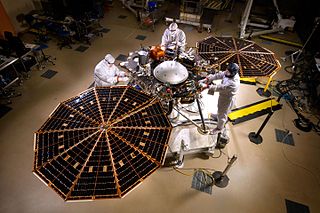
The Interior Exploration using Seismic Investigations, Geodesy and Heat Transport (InSight) mission was a robotic lander designed to study the deep interior of the planet Mars. It was manufactured by Lockheed Martin Space, was managed by NASA's Jet Propulsion Laboratory (JPL), and two of its three scientific instruments were built by European agencies. The mission launched on 5 May 2018 at 11:05:01 UTC aboard an Atlas V-401 launch vehicle and successfully landed at Elysium Planitia on Mars on 26 November 2018 at 19:52:59 UTC. InSight was active on Mars for 1440 sols.
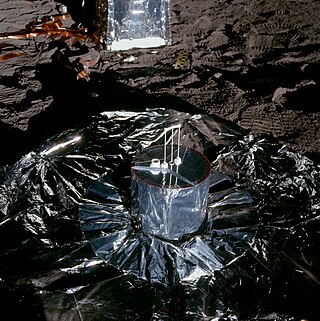
The Apollo 12 Passive Seismic Experiment (PSE) was placed on the lunar surface by the Apollo 12 mission as part of the Apollo Lunar Surface Experiments Package (ALSEP). The PSE was designed to detect vibrations and tilting of the lunar surface and measure changes in gravity at the instrument location. The vibrations are due to internal seismic sources (moonquakes) and external. The primary objective of the experiment was to use these data to determine the internal structure, physical state, and tectonic activity of the Moon. The secondary objectives were to determine the number and mass of meteoroids that strike the Moon and record tidal deformations of the lunar surface.
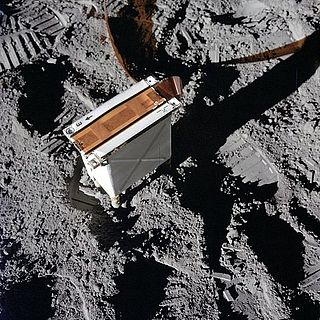
The Charged Particle Lunar Environment Experiment (CPLEE), placed on the lunar surface by the Apollo 14 mission as part of the Apollo Lunar Surface Experiments Package (ALSEP), was designed to measure the energy spectra of low-energy charged particles striking the lunar surface. It measured the fluxes of electrons and ions with energies from 40 eV to 20 keV. The primary purpose of the experiment was to examine plasma particles originating from the Sun and the low-energy particle flux in the Earth's magnetic tail.

The Seismic Experiment for Interior Structure (SEIS) is a seismometer and the primary scientific instrument on board the InSight Mars lander launched on 5 May 2018 for a landing on 26 November 2018; the instrument was deployed to the surface of Mars on 19 December. SEIS is expected to provide seismic measurements of marsquakes, enabling researchers to develop 3D structure maps of the deep interior. Better understanding the internal structure of Mars will lead to better understanding of the Earth, Moon, and rocky planetary bodies in general.
Active Seismic Experiment (ASE) was carried on Apollo 14 and Apollo 16 as part of the Apollo Lunar Surface Experiments Package (ALSEP). ASE used a thumper device and a mortar with explosive charges to explore subsurface lunar structure and elastic properties. The experiment's principal investigator was Robert Kovach of Stanford University. The experiment was succeeded on Apollo 17 by the Lunar Seismic Profiling experiment.
The Lunar Atmospheric Composition Experiment (LACE) was a miniature magnetic deflection mass spectrometer. The experiment's aim was to study the composition and variations of the lunar atmosphere. The only deployment of LACE was as part of the Apollo Lunar Surface Experiments Package (ALSEP) on Apollo 17 within the Taurus–Littrow valley.

The Passive Seismic Experiment Package (PSEP) was a scientific experiment deployed on the lunar surface by the astronauts of Apollo 11 as part of the Early Apollo Surface Experiments Package (EASEP). The experiment's goal was to determine the structure, tectonic activity, physical nature, and composition of the Moon. PSEP was the first seismometer to be deployed on a planetary body other than Earth.
